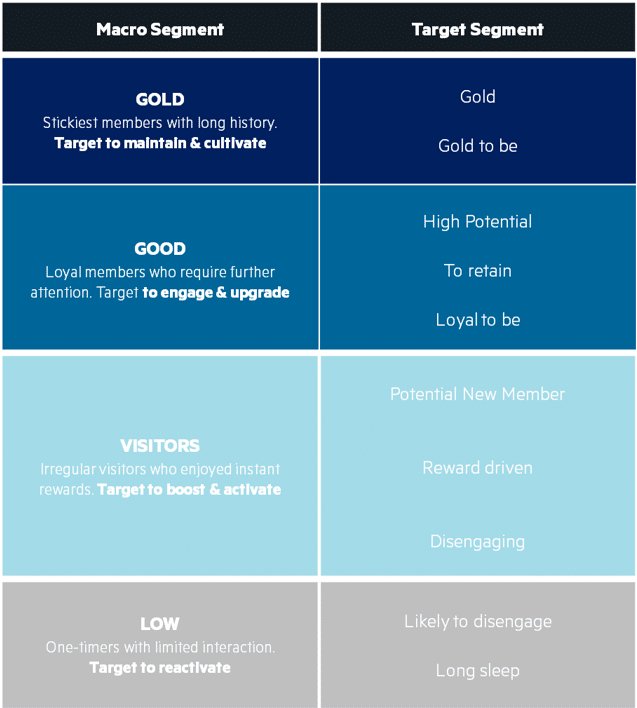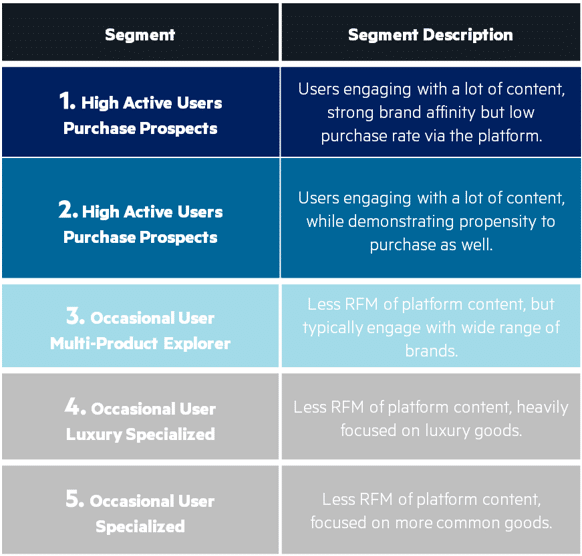
In the last two articles, we explored why it is important to adapt a new customer engagement strategy in post-COVID era, and how data-driven segmentations drive business growth through personalized engagement plans. In this final article, we will further delve into how Artificial Intelligence (AI) and analytics can help unlock the value of your customer data.
The evolution towards a cookieless digital advertising landscape poses new targeting challenges, underscoring the increased value of first-party data in enabling precise customer segmentation. There are four types of datasets which are typically found in corporations of all sizes which makes it feasible for brands to implement a data-powered strategy.

These datasets provide a holistic view on your customer behaviours across multiple factors like demographics, purchase patterns, and POS. It is common that companies will leverage the transaction data and segment the members based on certain rules, usually based on customers’ total spending, with follow-up analysis on the demographic, POS, and product preferences. This rule-based approach is simple and easy to understand, yet it is limited in the ability to capture complex and subtle patterns in the data – especially now with in the age of big data.
Considering the limitation of rule-based segmentation approach, we recommend brands to leverage machine-learning approach to perform segmentations, given its ability to capture and identify the intricate relationships and hidden patterns. From a business perspective, this approach offers greater flexibility to deliver more tailored and relevant experience, leading to improved customer satisfaction and loyalty. From a technology standpoint, machine-learning approach ability to process vast amounts of multi-dimensional data make it a more advanced and efficient option, ensuring businesses stay ahead in the dynamic market landscape and make data-informed decisions.
The following are client cases, led by Ekimetrics in APAC that leveraged machine-learning approaches. The methodologies are adapted based on the clients’ business goals:
Client Case 1: Segmentation based on Customers’ Loyalty Level
A leading real estate company in Greater China successfully employed advanced machine-learning algorithms to segment and prioritize their customers, leveraging an extensive dataset encompassing over 30 behavioural data points collected from their CRM system.
This new segmentation result empowers the company to transcend the limitations of a one-dimensional segmentation approach that solely centres on monetary values, enabling a deeper understanding of customer loyalty and responsiveness to diverse campaigns and promotion.

Client Case 2: Segmentation based on Customers’ Digital Footprint
A Japanese luxury beauty company faced declining customer engagement in a highly competitive industry – to address this challenge, the company collected second-party data from an online platform and applied advanced machine-learning techniques to the customers’ digital footprint on the platform.
The results enable the brand to target customers based on their activeness on the online platform and interest level to the content, with incentives to upgrade the customers to a more preferred segment.

Client Case 3: Predicted Potential to High-Value Customers
Apart from more general segmentation approaches, brands can apply machine learning prediction to the customer base to identify customers with highest potential to convert to high-value customers.
A global fashion luxury company, operating in APAC, developed scores to predict the likelihood of customers to become Very Important Customer (VIC) using AI – by analyzing 19 dimensions of customers. The company was able to predict the chances of each individual member moving to the VIC tier. This empowered the company’s Customer Intelligence and Retail teams to take a proactive approach to serve this group of high-potential customers.

First-party data originates directly from customer interaction with brands. Constructing a customer profile using this data captures the distinct attributes your customer base, enabling brands to craft a customized engagement strategy that forges deeper resonance with customers. It helps to answer three important questions:
Key business decisions, such as personalized marketing, cross-selling, star-product identification, can be based on customer profile characteristics. Segmenting customers based on demographics, behaviours and purchase potential can be useful in understanding interest in specific product categories across geographies.
Four takeaways for brands to start a data-driven CRM journey to build a better customer experience:
1. Integrate omnichannel experience for a seamless customer journey in the post pandemic era:
The shift in customer behaviors highlights the importance of having an effective omnichannel strategy: contemporary customers embrace digital channels while still valuing the essence of human interaction. To succeed, your strategy must seamlessly blend both aspects.
2. Leverage first party data to build customer profiles:
After defining an omnichannel strategy, a pivotal step entails the collection, upkeep and monitoring of data points spanning customer transactions, pertinent attributes, and product catalogues, extending across both digital and physical touchpoints. This approach is instrumental in crafting customer profiles with distinct attributes, thereby furnishing the foundational bedrock for the orchestrated implementation of the omnichannel strategy.
3. Apply machine-learning to generate actionable insights from customer profiles:
Leveraging machine-learning techniques, customer data across various touchpoints within the omnichannel ecosystem are combined to glean actionable insights. Customer profiles built with this dynamic approach unveil concealed patterns, preferences, and behaviors. All of these empower brands to decide the Who / What / Where / When / Why and How when engaging their customers.
4. Take business decisions for targeted segments across the customer funnel:
Leveraging customer segments, businesses gain the capability to drive customer activation, reactivation, retention, and acquisition. This facilitates precision in targeted marketing, cross-selling, identifying star products, thus enhancing overall business outcomes.
To find out more, read:
[VIDEO] 3 latest trends in Customer Centricity – with Olivier Kuziner, APAC GM. Watch Now!
Thought Leadership

Thought Leadership
